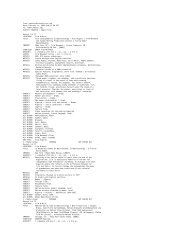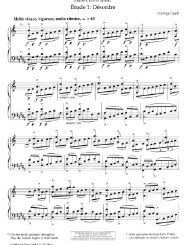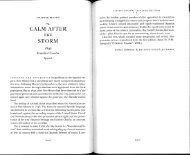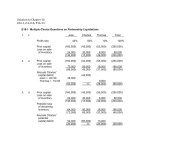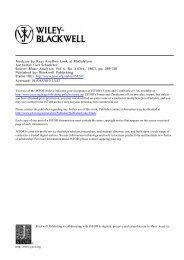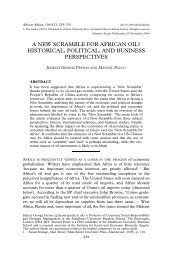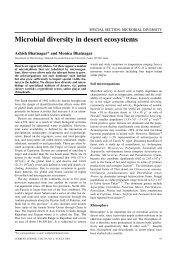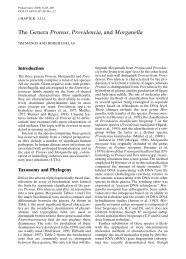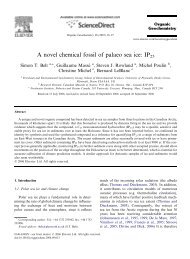The Genus Serratia
The Genus Serratia
The Genus Serratia
Create successful ePaper yourself
Turn your PDF publications into a flip-book with our unique Google optimized e-Paper software.
CHAPTER 3.3.11 <strong>The</strong> <strong>Genus</strong> <strong>Serratia</strong> 243<br />
<strong>Serratia</strong> marcescens isolates with special reference to the<br />
Grimont biotyping system. Journal of Clinical Microbiology<br />
23:230–234.<br />
Sifuentes-Osornio, J., Gröschel, D. H. 1987. Modification of<br />
Grimont biotyping system for epidemiologic studies<br />
with nosocomial <strong>Serratia</strong> marcescens isolates. Journal of<br />
Clinical Microbiology 25:567–568.<br />
Skerman, V. B. D., McGowan, V., Sneath, P. H. A. 1980.<br />
Approved lists of bacteria names. International Journal<br />
of Systematic Bacteriology 30:225–420.<br />
Slatten, B. H., Larson, A. D. 1967. Mechanism of pathogenicity<br />
of <strong>Serratia</strong> marcescens I. Virulence for the adult<br />
boll weevil. Journal of Invertebrate Pathology 9:78–81.<br />
Slotnick, I. J., Dougherty, M. 1972. Erythritol as a selective<br />
substrate for the growth of <strong>Serratia</strong> marcescens. Applied<br />
Microbiology 24:292–293.<br />
Smith, R. E., Hansen, H. N. 1931. Fruit spoilage of figs. University<br />
of California Agricultural Station, Bulletin.<br />
506:1–84.<br />
Smith, R. E., Reynolds, I. M. 1970. <strong>Serratia</strong> marcescens associated<br />
with bovine abortion. Journal of the American<br />
Veterinary Medicine Association. 157:1200–1203.<br />
Stanier, R. Y., Palleroni, N. J., Doudoroff, M. 1966. <strong>The</strong> aerobic<br />
pseudomonads: A taxonomic study. Journal of<br />
General Microbiology 43:159–271.<br />
Stapp, C. 1940. Bacterium rubidaeum nov. spec. Zentralbl.<br />
Bakteriol. Abt. 2 102:251–260.<br />
Starr, M. P., Grimont, P. A. D., Grimont, F., Starr, P. B. 1976.<br />
Caprylate-thallous agar medium for selectively isolating<br />
<strong>Serratia</strong> and its utility in the clinical laboratory. Journal<br />
of Clinical Microbiology 4:270–276.<br />
Steigerwalt, A. G., Fanning, G. R., Fife-Asbury, M. A.,<br />
Brenner, D. J. 1976. DNA relatedness among species of<br />
Enterobacter and <strong>Serratia</strong>. Canadian Journal of Microbiology<br />
22:121–137.<br />
Steinhaus, E. A. 1941. A study of the bacteria associated with<br />
thirty species of insects. Journal of Bacteriology 42:757–<br />
789.<br />
Steinhaus, E. A. 1959. <strong>Serratia</strong> marcescens Bizio as an insect<br />
pathogen. Hilgardia 28:351–380.<br />
Stephens, J. M. 1959. Immune responses of some insects to<br />
some bacterial antigens. Canadian Journal of Microbiology<br />
5:203–228.<br />
Stephens, J. M. 1963. Bactericidal activity of hemolymph of<br />
some normal insects. Journal of Insect Pathology 5:61–65.<br />
Stucki, G., Jackson, T. A. 1984. Isolation and characterisation<br />
of <strong>Serratia</strong> strains pathogenic for larvae of the New<br />
Zealand grass grub Costelytra zealandica. New Zealand<br />
Journal of Science 27:255–260.<br />
Tagaki, T., Kisumi, M. 1985. Isolation of a versatile <strong>Serratia</strong><br />
marcescens mutant as a host and molecular cloning of<br />
the aspartase gene. Journal of Bacteriology 161:1–6.<br />
Traub, W. H. 1972a. Bacteriocin typing of <strong>Serratia</strong> marcescens<br />
isolates of known serotype-group. Applied Microbiology<br />
23:979–981.<br />
Traub, W. H. 1972b. Continued surveillance of <strong>Serratia</strong><br />
marcescens infections by bacteriocin typing: Investigation<br />
of two outbreaks of cross-infection in an intensive<br />
care unit. Applied Microbiology 23:982–985.<br />
Traub, W. H. 1980. Bacteriocin and phage typing of <strong>Serratia</strong>.<br />
79–100.von Graevenitz, A., and Rubin, S. J. (ed.) <strong>The</strong><br />
genus <strong>Serratia</strong>. Boca Raton, CRC Press.<br />
Traub, W. H. 1981. Serotyping of <strong>Serratia</strong> marcescens: confirmation<br />
of five recently described new O antigens and<br />
characterization of an additional O antigen Zbl. Bakt.<br />
Hyg., I. Abt. Orig. A 250:307–311.<br />
Traub, W. H. 1982. Opsonization requirements of <strong>Serratia</strong><br />
marcescens. Zbl. Bakt. Hyg., I. Abt. Orig. A 253:204–224.<br />
Traub, W. H. 1983. Passive protection of NMRI mice against<br />
<strong>Serratia</strong> marcescens: comparative efficacy of commercial<br />
human IgG immunoglobulin preparations and rabbit<br />
anti-O, -H, -K, -Life cell and -protease immune sera.<br />
Zbl. Bakt. Hyg., I. Abt. Orig. A 254:480–488.<br />
Traub, W. H. 1985. Serotyping of <strong>Serratia</strong> marcescens:identification<br />
of a new O-antigen (O24). Zbt. Bakt. Hyg., I.<br />
Abt. Orig. A 259:485–488.<br />
Traub, W. H., Bauer, D. 1985. Degradation of human<br />
fibronectin by metalloproteases of <strong>Serratia</strong> marcescens.<br />
Zbl. Bakt. Hyg. A 259:461–467.<br />
Traub, W. H., Fukushima, P. I. 1979a. Further characterization<br />
of “promptly” and “delayed” human serum-sensitive<br />
strains of <strong>Serratia</strong> marcescens: simplified tube Oagglutination<br />
test and comparison with other serological<br />
procedures. Zbt. Bakt. Hyg., I. Abt. Orig. A 245:495–<br />
511.<br />
Traub, W. H., Fukushima, P. I. 1979b. Serotyping of <strong>Serratia</strong><br />
marcescens: simplified tube O-agglutination test and<br />
comparison with other serological procedures. Zbt.<br />
Bakt. Hyg., I. Abt. Orig. A 244:474–493.<br />
Traub, W. H., Kleber, I. 1976. Selective activation of classical<br />
and alternative pathways of human complement by<br />
“promptly serum-sensitive” and “delayed serumsensitive”<br />
strains of <strong>Serratia</strong> marcescens. Infection and<br />
Immunity 13:1343–1346.<br />
Traub, W. H., Kleber, I. 1977. Serotyping of <strong>Serratia</strong> marcescens.<br />
Evaluation of Le Minor’s H-immobilization test<br />
and description of three new flagellar H antigens. Journal<br />
of Clinical Microbiology 5:115–121.<br />
Traub, W. H., Raymond, E. A., Startsman, T. S. 1971. Bacteriocin<br />
(marcescin) typing of clinical isolates of <strong>Serratia</strong><br />
marcescens. Applied Microbiology 21:837–840.<br />
Traub, W. H., Spohr, M., Bauer, D. 1983. Resistance-plasmidand<br />
protease-independent murine virulence of a multiple-drug-resistant<br />
strain of <strong>Serratia</strong> marcescens. Zbl.<br />
Bakt. Hyg. A 256:184–195.<br />
Trias, J., Viñas, M., Guinea, J., Loren, J. G. 1988. Induction of<br />
yellow pigmentation in <strong>Serratia</strong> marcescens. Applied<br />
and Environmental Microbiology 54:3138–3141.<br />
Trought, T. E. T., Jackson, T. A., French, R. A. 1982. <strong>The</strong><br />
incidence and transmission of a disease of grass grub<br />
(Costelytra zealandica) in Canterbury. N. Z. J. Exp.<br />
Agric. 10:79–82.<br />
Véron, M. 1975. Nutrition et taxonomie des Enterobacteriaceae<br />
et bactéries voisines. Annales de Microbiologie<br />
126A:267–274.<br />
Virca, G. D., Lyerly, D., Kreger, A., Travis, J. 1982. Inactivation<br />
of human plasma α-proteinase inhibitor by a metalloproteinase<br />
from <strong>Serratia</strong> marcescens. Biochimica<br />
Biophysica Acta 704:267–271.<br />
von Graevenitz, A. 1977. <strong>The</strong> role of opportunistic bacteria<br />
in human disease. Annual Review of Microbiology<br />
31:447–471.<br />
von Graevenitz, A. 1980. Infection and colonization with<br />
<strong>Serratia</strong>. 167–186.von Graevenitz, A., and Rubin, S. J.<br />
(ed.) <strong>The</strong> genus <strong>Serratia</strong>. Boca Raton, CRC Press.<br />
Ward, P. A., Chapitis, J., Conroy, M. C., Lepow, I. H. 1973.<br />
Generation by bacterial proteinases of leukotactic factors<br />
from human serum, and human C3 and C5. Journal<br />
of Immunology 110:1003–1009.<br />
Wasserman, H. H., Keggi, J. J., McKeon, J. E. 1961. Serratamolide,<br />
a metabolic product of <strong>Serratia</strong>. Journal of the<br />
American Chemical Society 83:4107–4108.



